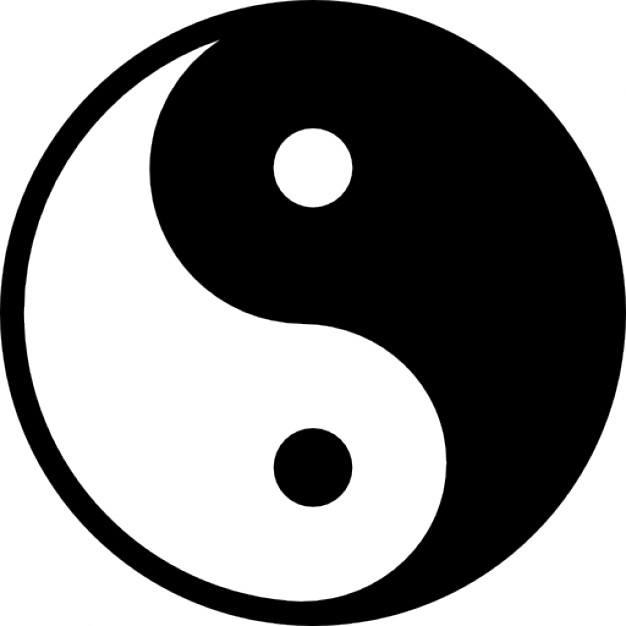The idea of my trying to connect the ancient Chinese philosophy of Yin and Yang to non-profit governance predates the addition of Gracie, the border collie, to our household. As pervasive as pet photos are, it is pure happenstance that her looks provide a good visual metaphor. Perhaps the notion of Yin and Yang offers some insight into her character.
I am not the first person to try to link the concept of Yin and Yang to ideas about leadership or management.((The terms Yin and Yang are capitalized when used as nouns, not when used as adjectives. The term or terms are sometimes used out of context or, when the context seems it might be appropriate, are only used to grab the readers attention rather than to explore their origin)) But can this concept provide boards and executive directors with useful insights in how better to govern their organizations? Perhaps so.
Charity and voluntarism are part of traditions, philosophies and belief systems other than those in the West.1 In Chinese philosophy, Taoism, the search for meaning, Yin is dominant. Confucianism, which is about social relations, favours Yang. The former values quiet reflection, the latter stresses the importance of engagement in life. The symbol, if not the terms, will be familiar to many people.
Yin and Yang
One can talk about Yin and Yang as two concepts but they are really not meant of be separate. Yin and Yang are the parts of a whole, parts in a symbiotic or complementary relationship.((For a bit more on this topic see Mark Cartwright’s overview of Yin and Yang in the Ancient History Encyclopedia, May 16, 2018)) They each embody energy and perspective. Yin, to name some of the features attributed to it, is:
- Feminine
- Dark
- Water
- Passive
- Quiet
- Earth
- Winter
- Even numbers
- Old
- Hidden
- Spirit giving
Yang is characterized as
- Masculine
- Light
- Fire
- Active
- Loud
- Summer
- Odd numbers
- Young
- Obvious
- Form giving
Its all about balance
Yin is regarded as dark, not evil dark, but difficult to know dark. Yin is more spiritual, more about feelings. It is about intuitive knowledge. And it is about the future. Yin, despite the stereotype, is regarded as the feminine side.
Yang is regarded as light, not as in good, but as in clear or unambiguous. Yang is more concrete, more logical. Disciplined, Yang is more about the present. Yang is the masculine side.
Yin is like the contents of a cup, Yang is the container itself. Yin is the peaceful flowing river, Yang the loud waterfall.((For these and other analogies see John Bellaimey’s The Hidden Meanings of Yin and Yang on YouTube))
The circular symbol suggests the relationship of two swirling forces….movement, not static. Yin and Yang are not so much about opposites. It, or they, represent the idea that the interaction of contradictory forces can help create harmony, a stronger more complete “whole”. Yin and Yang therefore are never completely in balance – they are always in motion in seeking balance, seldom arriving there.
The small dots within each of one (represented by black and white) symbolize that there is always some Yin (black) within Yang (white) and vice versa. Nothing is absolute with Yin and Yang. Yin (the black) contains a seed of Yang (in the form of a white dot). There is Yin, but interestingly, Yin is also Yang because it contains some Yang.
Non-profit governance
Most people who are, or have been, on a non-profit board might recognize, from the above description, that their work tends to be mostly yang. Creating policies, reviewing budgets, and setting fundraising targets are about managing, about the search for predictability and consistency. This is yang work.
I often hear complaints that board work seems unconnected to an organization’s purpose. Purpose, mission, vision and values though are hard to grab onto, yin not yang. We feel pressure to make them more concrete and actionable. Strategic planning which can start out as yin or makes forays into yin territrory, typically gets turned into yang by the end of the process.
Board meetings are typically yang. Packed agendas provide no time for reflection, no time for yin work. Yin ponders and questions from “left field”((I love the baseball origin of the term “left field” which seems appropriate here because if refers to the fact that the left fielder has the longest throw to first base)). Yang wants action, likes ready answers, values certainty and wants to move on.
If governance is about organizational and community leadership then perhaps it requires both Yin and Yang work. This is not about striving for balance all the time, it is about balance over time. Adding in opportunities for Yin work is not about disparaging Yang work. Together they are needed for a more complete approach to governance.
What might governance look like if there were more space for Yin?
- The acknowledgement, not just tolerance, of messy, chaotic discussion
- Different kinds of governance gatherings, not just board “business” meetings
- Greater reliance on individual board member study, reflection and writing
- Noticing of outlying questions and comments
On reflection
We have come to appreciate that Gracie really craves action but also benefits from some off-duty time away from the stimuli of the big world. She readily goes into her kennel when asked and, on her own, will retreat to a spot under the bed where she can sleep without having to keep an eye on things. We are hoping that as she matures we will see that there is room for more middle ground. We will all be happier with her appreciating Yin and Yang, not just being Yin or Yang.
***
The image is of our four-year old border collie, Gracie. Two humans care for her, or perhaps it is she that is caring for us. Gracie’s adventures can be followed on Instragram @gracieofnovascotia
- Asian Buddhism, for example, seems to support the idea of philanthropy in the idea of gift exchange. The words are dharma and dana. In Judaism, the Hebrew word tzedakah means righteousness, fairness or justice. In this tradition giving to the poor is not viewed as a generous act; it is an act of justice, It is a duty, giving to the poor is the right thing to do, an obligation to be acted upon regardless of ones financial standing [↩]



Fabulous article, Grant! A great new way (for me) to seek to persuade boards to leave more time for open discussions and meaningful preparation. Thank you. I will be sharing on Linked In. (Note: readers may not know that there are several non-profit related Linked In discussion groups that one can join. One is “NFP Governance Consultants in Canada.”)